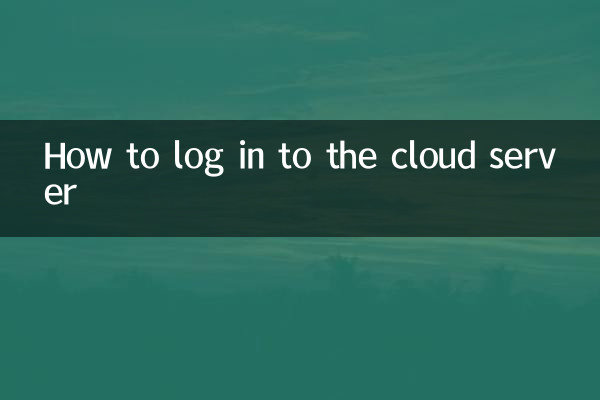How to log in to the cloud server
In today's digital era, cloud servers have become an important tool for enterprises and individuals to deploy applications and store data. However, for users who are new to cloud servers, how to log in may be a problem. This article will introduce in detail the steps, common problems and solutions to cloud server login, and combine it with hot topics in the past 10 days to help you quickly master relevant skills.
1. Basic steps for logging in to the cloud server

Logging in to the cloud server usually requires SSH (Linux) or remote desktop (Windows) protocols. Here are the specific steps:
| steps | Operating Instructions |
|---|---|
| 1. Get login information | Obtain the server's IP address, username, and password (or key) from the cloud service provider's console. |
| 2. Select the login tool | It is recommended to use PuTTY or Terminal for Linux systems, and remote desktop connection for Windows systems. |
| 3. Enter login information | Enter the IP address, username and password (or key file) into the tool. |
| 4. Connect to the server | Click Connect. You may need to confirm the host key when logging in for the first time. |
2. The correlation between hot topics and cloud servers in the past 10 days
The following are the hotly discussed topics on the Internet recently, many of which are related to cloud server technology:
| hot topics | Related points |
|---|---|
| AI large model application explosion | Cloud servers are the infrastructure for training and deploying AI models, and login management is a necessary skill. |
| Data security incidents occur frequently | Cloud server login requires strengthened password and key management to prevent unauthorized access. |
| Normalizing remote working | Cloud servers provide a collaborative environment for remote teams, and convenient login is the key. |
3. Common problems and solutions
The following are typical problems and solutions that users may encounter when logging into cloud servers:
| question | solution |
|---|---|
| Connection timeout | Check whether the IP is correct and whether the firewall allows SSH (port 22) or RDP (port 3389). |
| Authentication failed | Confirm that the username/password is correct, or check that the key file matches. |
| High network latency | Select a cloud server region that is closer to the user's geographical location. |
4. Advanced techniques and precautions
1.Key login is more secure: It is recommended to use SSH keys instead of passwords to avoid the risk of brute force cracking.
2.Multi-factor authentication (MFA): Enable MFA for the cloud console to improve account security.
3.Login log monitoring: Regularly check /var/log/auth.log (Linux) or Event Viewer (Windows) to detect abnormal login attempts.
5. Summary
Mastering cloud server login skills is the first step to using cloud computing services. Whether you are deploying a website, running data analysis, or building a development environment, a stable login connection is the basic guarantee. Combined with recent hot technology trends, cloud server management capabilities are becoming an important part of the digital competitiveness of individuals and enterprises. It is recommended that users become familiar with the operation through practice and continue to pay attention to security best practices.

check the details

check the details